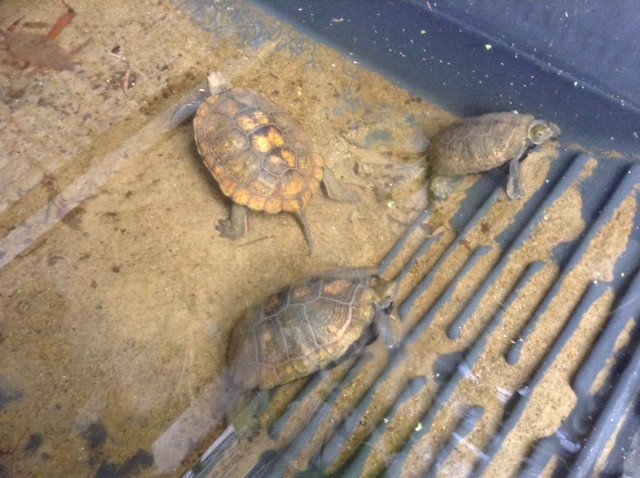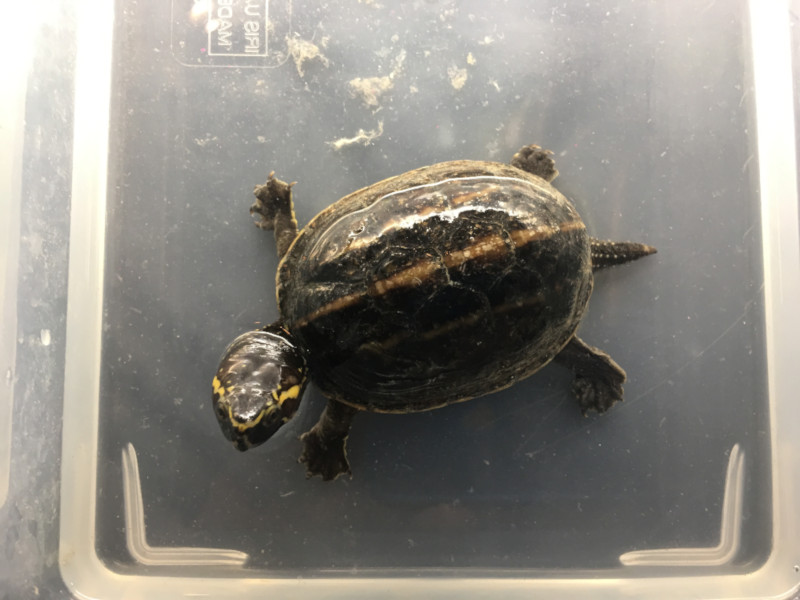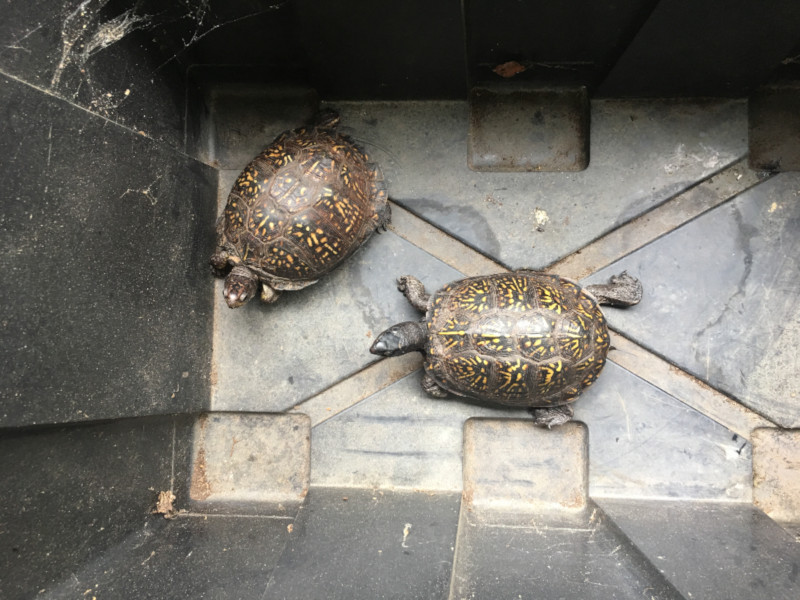Nihon Ishigame Five Years Later Part One:
The Pursuit of Excellence, Happiness & The Perfect Day Continues
by Jeff Fullerton
[email protected]
Attribute to L. Neil Smith’s The Libertarian Enterprise

Five years.
Hard to believe it's been that long already since the arrival of the adult trio of Japanese Pond Turtles in the early spring of 2014. An event that marked a big turnover in my focus as a reptile hobbyist; from native to exotic species to avoid—at least for the time being—the red tape associated with the former. That was explained more in depth in the first article in this thread Nihon Ishigame: An Outlaw Turtle Enthusiast goes Japanese http://www.ncc-1776.org/tle2014/tle764-20140330-04.html and in subsequent articles and I encourage the readership to explore those on their own rather than repeat a lot of that information. It was more or less a decision born of my desire to escape—at least temporarily the regulatory clutches of my state wildlife regulatory agency that I said and still stand by my claim; was insanely prejudiced against the interests and activities of amateur reptile and amphibian hobbyists.
I say temporarily because the regulatory agencies and the career bureaucrats and activist ideologues that have managed to capture and control them have an insatiable appetite for destroying virtually all human liberties. Since L. Neil Smith republished his old essay: Animals Are Property as part of an open—letter/tweet to Pamela Anderson in response to a recent Fox News interview where she expressed some of her views on the issues of “Animal Rights” this prompted me to a web search that netted a page with her striking a pose in a bikini with her body marked off for the various cuts of meat; shoulder, breast, ribs, rump leg, … You get the picture. She did look quite delicious to say the least making me wonder if she and PETA are conspiring to promote cannibalism in the guise of vegetarianism? But I digress. The page belongs to PETA whose motto is; Animals Are Not Ours—which is in essence is the antithesis of Animals Are Property. But as Neil's essay says and Harding McFadden's article “The Fox Realization” which I somehow overlooked until this Saturday afternoon when I sat down to compose this one; those who advance the cause of animal rights don't usually believe in human rights. Especially the rights of humans other than themselves to live their lives free and pursue happiness. And then you have their fellow travelers—the deep ecology ideologues who don't even value the lives of individual animals or even species as I have heard all too many times that it is better for endangered ones hanging by a thread at the cliff of extinction to go quietly into the night than it is for them to be commercialized and prostituted as pets or even for public exhibition in zoos or circuses. That right there ought to be enough to convince anyone with half a brain that these people are full of crap. But they still have to be taken seriously because they are a clear and present danger to Life, Liberty and the Pursuit of Happiness.
And to the pursuit of Excellence which what I
really want to focus more on.
That is what I have been focusing mostly on after a winter of
soul searching and sifting through the mistakes of the recent past.
When you maintain a large collection of animals—you are bound to run
into problems sooner or later. Predators , disease , natural
catastrophes like the sudden cold snap that caught me off guard late
last season and cost me two really awesome Gulf Coast Box Turtles—my
only two male breeders. That was an awful setback given that these
animals have been in my possession since the mid 1990s—which
ironically goes back close to the date that El Neil first published
his essay on the right of animal ownership—talk about blast from the
past! That's time long enough to bond heavily with a pet—and I won't
cower under the politically correct euphemism that animal keepers
often use as a vain attempt to placate the animal rights crowd;
animal companion. Even if I do sometimes think of my charges as
companions. Especially when they've been with me for a long time.
Companions, pets, whatever. I prefer the term pet because it does elevate the status of an animal to something above just specimens or livestock—which they tend to start out as—until we bond with them and they with their keeper. In a way it's often a more enduring bond than an animal acquired because of its awesomeness and appeal—though most of those become cherished pets over time. By now I've probably earned a lot of hate mail from any animal rights person or hard core biocentric ecologist that might lurk around reading this journal. If so then so it. I can only hope that such persons get a little inoculation of logic and reason and if they truly love animals they will understand that their way is not the only way to care about and conserve animals and the natural world in general.
In the course of my lifetime—50 some years I've watched the reptile hobby grow from a time when it was mostly baby Red Ear Sliders in pet shops and five & dime stores and an assortment of wild caught native and foreign species that were oft times disease and parasite ridden and poorly cared for—mainly because the art of Herpetoculture was in its infancy in comparison to more familiar fur bearing and feathered critters that have been in domestication for thousands of years. In a span of about 40 years we've come from that to a huge cottage industry of private breeders producing all kinds of rare and beautiful species and a kaleidoscope of color morphs of the more common ones. From what I've been reading and seeing first hand at reptile shows—there have probably been more morphs of each of the most commonly bred species—Red Ear Sliders, Corn Snakes, Ball Pythons and Leopard Geckos produced in the last 20 years than there are of Goldfish dating back to ancient China!
Of course there are people who would deplore such as tampering with Nature and the idea of altering species let along exploiting them is anathema. Personally I like the natural wild types or forms that are selectively bred to enhance color or pattern but still not far removed. To each their own. As for exploitation—that is mostly a cultural Marxist concept to argue for the dissolution of private ownership and the concept of common ownership of wildlife was always a foot in the door for collectivizing land and natural resources. So as it pertains to the issue of keeping animals—it is more about advancing that agenda than animal welfare or environmental protection. I somehow could sense it then back in the day when I got into arguments with people over these issues on various email forums. Their indignation was pretty much the same as most left wing arguments on capitalism. Capitalism was in their view a bad thing and needed to be abolished and it was fundamentally wrong to privately own or commercially profit from the sale of wildlife. That was a big part of the deeply entrenched philosophy of the Pennsylvania Fish and Boat Commission which was applied when they were given stewardship of the state's native reptile and amphibian fauna. And sort of the view of many hunters and sport fishermen who embrace the core value of the American wildlife management philosophy established during the Progressive Era; that Wildlife must be kept wild and belongs to all the people and must not be reduced to private ownership.
It is never a good idea to compromise these enemies of liberty who are hellbent on throttling human freedom anyway they can. The only thing that will work to safeguard our interests as hobbyists is to push back and defeat them. Expose the cultural Marxists for what it is in the battlefield of ideas. Their history has a wretched track record in the last century and in this one it's not working very well either. In Venezuela, they've probably finished off the big zoo critters and are now moving down the food chain to snakes and turtles. So obviously socialism is hardly a friend to animals!
Considering that; it's hard to not think of what Jerry Pournelle said about what would happen to much of the wildlife on Planet Earth if the technologically advanced civilization that radical environmentalists so loathed happened to collapse leaving behind starving masses of billions of humans.
As for the matter of confronting people who think that humans have no right to eat or keep animals as pets—it would be interesting to ask Pamela Anderson the question I once asked a lady friend many years ago—who was vegan / animal rights advocate; “If eating meat is such a terrible thing; what about animals that eat other animals”? Obligate carnivores such as lions and tigers and crocodiles that have to take the lives of other living, breathing and most importantly—feeling creatures with the capacity for experiencing fear and pain. Including humans! I'm guessing the reply might be the same: “Isn't it terrible”? Except maybe for the humans who in their opinion might deserve to become lunch. Of course it's hard to be human and not think such of some fellow humans. There are plenty of assholes out there who do deserve it. And it may be natural for us to think this way being that we are the apex predator species on this planet and the majority of threats aimed at us apart from natural disasters come from other people. That's probably the source of much of the misanthropy as it pertains to animal rights and environmental issues as well as the immigration issue. Animals—even varmints that destroy crops and livestock or even attack us from time to time seem to be far less troublesome than human competitors or enemies.
I tend to think of Libertarianism and the idea of individual human rights as a quantum evolutionary leap over primitive collectivism and social pecking orders that are typical of most non-sapient social animal species and residual in human societies to varying degrees. Since Mankind is naturally a predatory species that not only uses animals for its own sustenance and utility—it is just as natural for us to do that as it is for lions to pull down antelope and eat them. Sometimes ripping out and chewing on their guts while there're still alive and kicking! At least it can be argued that for the most part—when humans kill animals for food or whatever other reason—we try to do it quickly and humanely. The animal rightists may argue that to be a lame rationalization but would it be any difference if they argued the same if they were in power and using deadly force against other humans who refused to obey their laws?
Which is ultimately what it will come down to if they win. In such a scenario you kill and eat a deer or do something else in violation of their rules when such becomes the law of the land—maybe you killed some varmint like a raccoon or fox that was raiding your chicken coop or fish pond—and the police will be sent to arrest you and if you refuse to surrender and go quietly you could very well be killed much the same as what would happen if you one day stopped paying your taxes. And I'm sure the people who lobbied for such laws would condone it. It would be the same for me if they came for my turtles and I refused to give them up.
I will stand by Neil's declaration I read in yet another essay from his Lever Action book that said something about animals existing for the sustenance and amusement of their evolutionary superiors—namely human beings who have mastery over the lesser forms—at least until some unstoppable cosmic or geophysical catastrophe—or perhaps just collective stupidity puts an end to our existence as a species. I more often than not dread the later possibility given the stupidity that prevails in our popular culture and politics!
Never the less I resolve to trudge on and advance as I learn from my mistakes and strive to improve. I started out with the intent to make this article more about the positive things in the reptile hobby rather than fixating so much on the doom and gloom of all the forces that are trying to destroy it. It's a serious issue but maybe not as bad as we are tempted to imagine. There have been some bad stories lately like one about a house in Madagascar being used by smugglers to stage hundreds—if not thousands of critically endangered tortoises under really deplorable conditions https://m.youtube.com/watch?v=HrDkxlNTo_g and a few big busts stateside including a scenario that involved a South Carolina man shot dead https://www.thestate.com/latest-news/article214191799.html in what looked like a drug deal gone bad but may have just been a domestic homicide. Still the overall good outweighs the bad. There are lots of success stories involving species new to the trade, great breakthroughs in husbandry too numerous to name. And the reptile shows that I've been to lately have been amazing to say the least.
I went to the Pittsburgh show twice this summer in hope of getting a male Gulf Coast Box but unfortunately came up empty. I did however find a male Striped Mud so I now will have the means to continue breeding my three females that have been without a male for some time.
There was also good news from Kamp Kennan. The missing Fly River turtle ordeal had a happy ending much like my episode of Franklin gone AWOL.
https://m.youtube.com/watch?v=imFHJ_i6oXY
As hoped by all who were watching that story; the
animal turned up later in another pond on the property!
Like me, he made a mistake and learned from it and applied the
lesson to improving his security much like I did when I tacked metal
flashing around the interiors of my pens to make it harder for the
turtles to climb out if I forget to close the lids.
To end this on a really good note I did finally find a replacement for Franklin and the other male that perished this past winter. This time; a male / female pair which turned out to be a good deal. I found an ad in the Fauna Classifieds for long term captive adults that by the look of the growth rings on their scutes—have been established in captivity for a long time and were likely captive bred. Those are settling in and feeding well in one of my vacant pens in quarantine and if everything goes right—they'll be merged with my remaining Gulf Coast flock consisting of an adult female and her numerous progeny next spring.
And I'm also awaiting the arrival of a five year old captive bred male Florida Box turtle that I ordered just a week after the arrival of the new Gulf Coast pair—who will be arriving this coming week from a breeder in California—of all places! I must say they do have a lot of good reptile breeders out there and I will have to elaborate on that as I report on the progress of these animals along with the continuation of the Pursuit of Happiness and Excellence in Part Two of this article.
Which is to paraphrase Kenan Harkin: what it's really all about!
https://m.youtube.com/watch?v=t2u_McE2jbM
As for the Perfect Day; it continues to elude me on the account of time and weather issues. Maybe by next time it will come to pass.
Male Striped Mud Turtle I bought at the Pittsburgh Reptile Show in June. He was exactly what I was looking for and seemed to be begging “Take me home”!:

Two really nice “specimens” who will hopefully establish themselves and bond with me just like Franklin did. The one in the center is the male who looks quite different from Franklin or his other male cohort that passed last winter. Yet they are in many ways similar. They came from LL Reptiles in California and are said to be long term captives sourced from a local turtle enthusiast who was either downsizing some of his or her flock—or getting out of it altogether as hobbyists inevitably do when they become less capable of caring for their animals due to personal circumstances , illness or age. That is an excellent way to acquire rare species without removing more from the wild and can allow a keeper to pass on his breeding project to someone else or distribute them to multiple collections that can function as assurance colonies for many species that are imperiled in their home countries.

Was that worth reading?
Then why not:
![]()
AFFILIATE/ADVERTISEMENT
This site may receive compensation if a product is purchased
through one of our partner or affiliate referral links. You
already know that, of course, but this is part of the FTC Disclosure
Policy
found here. (Warning: this is a 2,359,896-byte 53-page PDF file!)
